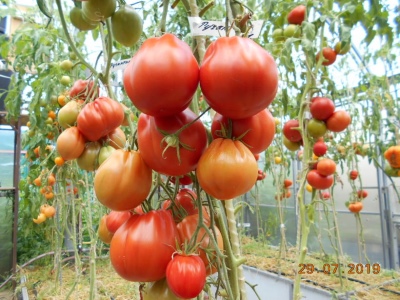
- Year of approval: 2015
- Name synonyms: Rugantino
- Category: hybrid
- Growth type: indeterminate
- Appointment: fresh consumption
- Ripening period: ultra early
- Ripening time, days: 80-85
- Growing conditions: for film greenhouses
- Bush size: tall
- Bush height, cm: 150-200
Highly efficient tomatoes for film greenhouses are widely demanded in domestic conditions. The Rugantino variety can reasonably be considered one of the best options. But even it must be applied correctly - and for this to know what exactly to do.
Description of the variety
The tomato, bred relatively recently and registered in 2015, has an alternative name Rugantino. At its core, this is a classic indeterminate hybrid (which means the need to artificially limit its growth). As already mentioned, such a tomato is designed for film greenhouses. It forms tall bushes, up to 1.5-2 m. Plants develop vigorously and have shortened internodes. Leaves of medium length are colored in the usual green color.
The main qualities of the fruit
The initially green Rougantino berries will turn red over time. They are large and weigh 0.15-0.2 kg. Other parameters are worth emphasizing:
- pear-shaped;
- average level of ribbing;
- formation from complex inflorescences.
Taste characteristics
The red pulp of such a tomato is moderately dense. It is consumed mostly fresh. Pleasant fleshiness of the harvest is noted.
In general, a sweet note dominates the flavor ensemble. However, there is always an expressive sourish inclusion there. Salads, summer snacks, and other light meals work well.
Ripening and fruiting
A notable feature of this variety is its particularly early ripening. Normally, 80-85 days pass from the stage of green shoots to the development of strong and tasty berries. But sometimes, of course, various circumstances interfere with this established schedule.
Yield
The collection can reach 12.3 kg per 1 sq. m. In a particular case, the level of productivity is sometimes different. However, it is enough to take into account the weather conditions, choose the right site and take care of the planting in order to eliminate most of the problems.
The timing of planting seedlings and planting in the ground
The sowing season for seedlings begins on March 10-15. It usually ends from April 30th to April 5th. The specific dates are chosen, taking into account the climatic features of the region, the available and expected weather. Sowing when trying to grow Rougantino in the open field is carried out approximately on April 10-15. The approximate time between sowing and transfer to the final growing site is 35-45 days; it is desirable to have 8-10 true leaves and 1 flower cluster.

Growing tomato seedlings is an extremely important process, because it largely depends on whether the gardener will be able to harvest at all. All aspects must be taken into account, from seedbed preparation to planting in the ground.
Landing scheme
For 1 sq. m you can plant no more than 4 bushes. In this case, ideally, for ease of cultivation, it should be limited to 3 plants. Both options involve keeping bushes in 1 stem. With a larger number of branches, a good harvest will have to be forgotten.

Growing and care
Rougantino seedlings are easiest to get in peat pots. The optimal size of containers is 100x100 mm. The most active plants dive 14 days after planting. Young seedlings need especially active watering. They need a lot of light and warmth, otherwise they cannot count on normal development.
Such a tomato is able to develop successfully even when there are no special conditions for other plants. For example, if pollen of other varieties turns out to be sterile in intense heat, then everything will be all right with Rougantino. It is worth noting unofficial indications that this plant develops well in mild climates. Tall branches are usually attached to trellises. At the very beginning of summer, pinch the growth point, thereby guaranteeing the ripening of the crop before the onset of frosty time.
About 24 hours before planting, the bushes should be watered abundantly. Each plant is planted by adding at least 10 kg of first-class soil to the hole. Top dressing a week after planting involves the use of a nitroammophoska. The rest of the time, chicken manure is used, and as soon as the first fruits appear, complex fertilizers are needed. Shows pruning of stepchildren and old dry foliage.




A plant needs different micronutrients at each stage of growth. All fertilizers can be divided into two groups: mineral and organic. Folk remedies are often used: iodine, yeast, bird droppings, eggshells.
It is important to observe the rate and period of feeding. This also applies to folk remedies and organic fertilizers.


Growing regions
This variety can be grown almost throughout Russia. Both in the North Caucasus and in the foothills of the Sayan Mountains, in the vicinity of Moscow and St. Petersburg, it will give excellent results. The only exceptions are areas with the most severe climates.

























































































